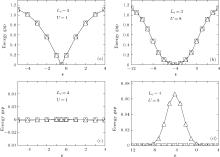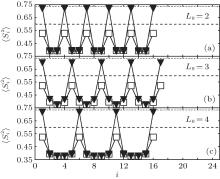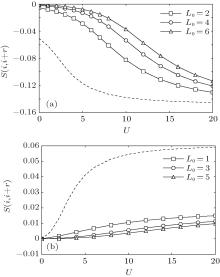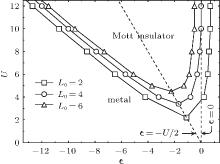†Corresponding author. E-mail: dlzhang@whu.edu.cn
*Project supported by the National Natural Science Foundation of China (Grant Nos. 50573059 and 10874132).
We investigate the charge and spin gaps, and the spin structure in half-filled one-dimensional Hubbard superlattices with one repulsive site and L0 free sites per unit cell. For odd L0, it is correlated metal at the particle–hole symmetric point, and then turns into band insulator beyond this point. For even L0, the system has a Mott insulator phase around the particle–hole symmetric point and undergoes a metal–insulator transition with on-site repulsion U increasing. For large U, there exists a multiperiodic spin structure, which results from the ferromagnetic (antiferromagnetic) correlation between the nearest neighboring repulsive sites for odd (even) L0.
It is widely believed that the strong electronic correlation is of key importance to high-Tc superconductors and determines the behavior of transition metal oxides.[1] Up to now, the phase transition in strongly correlated electron systems is still the focus of interest in modern condensed matter physics. The minimal model that describes the essential physics of such systems is the one-band Hubbard model.[2] This model on a one-dimensional (1D) lattice has been exactly solved.[3] When the local interaction U is repulsive, the hall-filled 1D Hubbard model undergoes a metal– insulator transition (MIT) at U = 0 and the insulator is a Mott insulator with gapless spin and gapped charge excitations. This insulating state is incomprehensible within ordinary electron band theory and it is the result of strong electronic correlation. The Mott-type ground state has a characteristic spin-density-wave (SDW) with power-law decay of spin correlations.
Yet the Hubbard model is a homogeneous one with uniform repulsive interaction and on-site orbital energy. In consideration of the fact that real materials usually consist of several different kinds of atoms, some modified inhomogeneous Hubbard models are proposed. The ionic Hubbard model (IHM) with alternating potentials ± Δ at adjacent sites is regarded as a description to the neutral– ionic transition in mixed-stack organic charge-transfer salts[4, 5] or the ferroelectric transition in perovskite oxides.[6, 7] In 1D IHM, when U increases, the transition is from a band insulator to a Mott insulator, via a bond-ordered, ferroelectric insulator.[8– 15] The Hubbard chains with special site-dependent potentials, such as the Fibonacci and Harper modulation, are also discussed.[16] The alternating Hubbard model (AHM) with different UA and UB on neighbouring sites has been reported to simulate the systems whose spatial invariance is broken by two types of atoms, say “ anions” and “ cations” .[17, 18] In the phase diagram of AHM, the system is always insulating and two types of regions, dominated by SDW and charge density wave (CDW), are observed.[18] The generalized inhomogeneous model with site-dependent U has been also discussed.[19] For considerable insight into the nonrandom inhomogeneous systems such as magnetic multilayer and superlattice, [20– 23] a 1D superlattice model with periodic arrangement of repulsive and free sites, but with constant orbital energy, has been widely studied for many different unit cell configurations and electron fillings.[24– 30] The Mott– Hubbard insulator sets in at filling density ρ I for these superlattice structures, [25] not at half-filling as in the Hubbard model. The period of SDW and the profile of local moment have rich properties.[27] Here, we consider a more realistic superlattice model with the following Hamiltonian:

where i runs through all sites of the one-dimensional superlattice; 

The electronic and magnetic properties of model (1) have been investigated by Lanczos diagonalization, [31] where the system size is typically less than 10. Some significant methodological studies imply that the properties of superlattice (1) are more sensitive to the modulation of ε than that of U.[32– 34] In the previous work for LU = L0 = 1, [35] the system shows a correlated-metal phase at the particle– hole symmetrical point and becomes a band insulator beyond this point. The phase transition in superlattices with other combinations of LU and L0 has not been reported.
In this paper, we report charge and spin energy gaps and magnetic properties for superlattice Hamiltonian (1) at half-filling with the help of the density-matrix renormalization group (DMRG) procedure.[36– 40] The unit cell of the superlattice here has L0 = 1 to 6 free site(s) and LU = 1 repulsive site. Section 2 presents the charge and spin excitations and the MIT of the Hubbard superlattice. In Section 3, magnetic properties, including local moment profile and SDW structure factor, are discussed. Section 4 gives the phase diagram and a summary.
The charge and spin excitation gaps Δ C and Δ S of the superlattices with N sites at half-filling can be given by


respectively. E0(Ne, N↑ , N↓ ) is the ground state energy, Nσ (σ = ↑ or ↓ ) is the number of electrons with spin σ and thus the total number of electrons Ne = N↑ + N↓ and Ne = N at half-filling. To get the gaps in the thermodynamic limit (N → ∞ ), the finite-system DMRG algorithm is employed for chains with different lengths. We use a quadratic polynomial in 1/N to extrapolate the energy gaps under the thermodynamic limit[35]

where x can be C (charge) or S (spin).
We start by examining the behaviors of energy gaps at the particle– hole symmetric point ε = − U/2. The finite-size behaviors of the spin and charge gaps for a superlattice with L0 = 2 are shown in Figs. 1(a) and 1(b), respectively. For a definite chain length N, the spin gap Δ S decreases with on-site repulsion U increasing. However, the extrapolation in Fig. 1(c) displays that as N → ∞ , Δ S tends to be gapless regardless of the repulsion U (Δ S for N → ∞ is also plotted in Fig. 1(a)). Nevertheless, with U increasing, the charge gap Δ C in Fig. 1(b) hardly changes for small U. When U is large enough, Δ C goes up rapidly. In the thermodynamic limit N → ∞ shown in Figs. 1(b) and 1(d), the charge gap Δ C vanishes for small U and appears when U exceeds a critical Uc. Therefore, there is an MIT at U = Uc for the superlattice with L0 = 2 and the insulator state is the Mott insulator, in which Δ C is finite and Δ S vanishes.
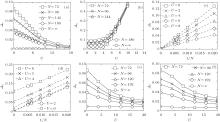 | Fig. 1. The spin gap Δ S and charge gap Δ C as functions of U and system length N for panels (a)– (d) L0 = 2 and panels (e) and (f) L0 = 3. ε = − U/2. |
For superlattices with odd L0, the MIT is not observed. The charge and spin gaps Δ C and Δ S with L0 = 3 are shown in Figs. 1(e) and 1(f), respectively. It is found that both energy gaps decrease with U increasing for a definite N. In the thermodynamic limit N → ∞ , the gaps vanish and the ground state with L0 = 3 is always metallic at half filling and the particle– hole symmetric point ε = − U/2. In the previous work for L0 = 1, the particle– hole symmetrical point is a correlated-metal point at half-filling.[35] Our calculation shows that for other odd L0 (e.g., L0 = 3, 5), this conclusion is kept.
The MIT transition points for superlattices with different even L0 at half-filling are checked and the result is shown in Fig. 2. It is seen that for larger L0, Δ C increases more slowly with U increasing and critical Uc increases. The critical Uc for superlattices with L0 = 2, 4, and 6 are 2.2, 3.4, and 4.5, respectively. One recalls that this phase transition also happens in the one-dimensional Hubbard model at half-filling where the transition occurs at U = 0. When the superlattice structure is present and there are more free sites in a unit cell, a stronger repulsive interaction is required to give rise to a Mott insulator phase.
Next, we turn to the properties of superlattices without particle– hole symmetry. When one observes the effect of orbital energy ε i, the energy difference between sites is essential. Without loss of generality, ε i at free sites are regarded as zero and ε i = ε at repulsive sites. ε is changed to adjust the distribution of electrons. As shown in Fig. 3, we choose superlattices with L0 = 3 and 4 to demonstrate how ε affects the charge and spin excitations. For odd L0 (e.g., L0 = 3), the charge and spin gaps Δ C and Δ S always have the same values and are opened beyond the particle– hole symmetric point. This feature indicates that the superlattice with odd L0 becomes a band insulator at half-filling when the particle– hole symmetry is broken. For even L0 (e.g., L0 = 4), the spin excitation is always gapless. For small repulsion U, the system is always metallic while for large U (e.g., U = 8 in Fig. 3(d)), the system persists as a Mott– insulator just around the particle– hole symmetric point ε = − U/2 and the MIT occurs when ε is far away from − U/2. A phase diagram for superlattices with even L0 is given in Section 4.
The local moment 



For the superlattice with particle– hole symmetry, figure 4 displays the local moment profile within the range of several periodic cells. Regardless of the superlattice structure and the value of U, 


Now, we study the static spin structure factor to describe the spin correlation, which is defined as

We consider 
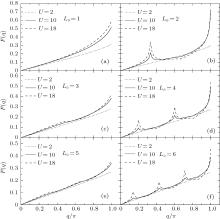 | Fig. 5. Static spin structure factor F(q) for ε = − U/2 and different L0 and U. (a) L0 = 1; (b) L0 = 2; (c) L0 = 3; (d) L0 = 4; (e) L0 = 5; (f) L0 = 6. |
It is worth noting that there is the cusp structure in the Hubbard model for different electron filling density ρ .[41] For instance, SDW has a cusp at qmax = 2kF = π ρ for ρ ≤ 1, or qmax = 2kF = π (2 − ρ ) for ρ ≥ 1. For the superlattice model in Ref. [27], a two-peak structure is observed in a specific electron density region while there is only one peak at q = π at half-filling (see Fig. 6 therein). In our Hubbard superlattices, the multiperiodic SDW is found at half-filling and the particle– hole symmetric point.
In order to understand the above characteristics of static spin structure factors, we consider the local spin correlation 
We have investigated the charge and spin gaps and spin structure in 1D half-filled Hubbard superlattices with one repulsive site and L0 free sites per unit cell. For odd L0, the charge and spin gaps always have the same values. There is a correlated-metal phase at the particle– hole symmetric point ε = − U/2. The superlattice is a band insulator beyond ε = − U/2. As U increases, for odd L0, there are some slight uplifts in the spin structure factor, which results from the ferromagnetic correlation between the repulsive sites. For even L0, the MIT is observed and the phase diagram is shown in Fig. 7. The system is a Mott insulator around the particle– hole symmetric point ε = − U/2. The spin excitation is always gapless. The charge gap vanishes for small U and opens for U > Uc. In the insulator regime, we observe a multiple-peak structure in the spin structure factor, which results from the antiferromagnetic correlation between the nearest neighboring repulsive sites.
Our results show that the electronic and magnetic properties of the Hubbard superlattice model (1) have an interesting odd– even L0 disparity. Some results can be qualitatively understood by energy band theory. For the superlattice, if L0 is odd, the length of unit cell is even and the number of bands is also even. At half-filling, half of the bands are filled. The system is metal or insulator depending on the properties of the bands around Fermi level. However, when L0 is even, half-filling makes the middle band cross the Fermi level and this band splits under the interaction of U, which causes the superlattice to be an insulator. The interaction of U on the band also occurs in the one-band Hubbard model. This kind of odd– even disparity is also found in the linear periodic atomic chains of carbon-transition-metal TM-Cn.[42, 43] The first-principles calculation shows that for linear carbon-transition-metal compounds, the relative position of energy bands depends on the number of carbon atoms. Hence, spin-dependent electronic properties also vary according to odd or even carbon atoms. In conclusion, although the importance of nanoscale spatial inhomogeneity has been widely recognized, [32] the effort in experiment and theory should be made to understand properly the consequence of nanoscale inhomogeneity.
| 1 |
|
| 2 |
|
| 3 |
|
| 4 |
|
| 5 |
|
| 6 |
|
| 7 |
|
| 8 |
|
| 9 |
|
| 10 |
|
| 11 |
|
| 12 |
|
| 13 |
|
| 14 |
|
| 15 |
|
| 16 |
|
| 17 |
|
| 18 |
|
| 19 |
|
| 20 |
|
| 21 |
|
| 22 |
|
| 23 |
|
| 24 |
|
| 25 |
|
| 26 |
|
| 27 |
|
| 28 |
|
| 29 |
|
| 30 |
|
| 31 |
|
| 32 |
|
| 33 |
|
| 34 |
|
| 35 |
|
| 36 |
|
| 37 |
|
| 38 |
|
| 39 |
|
| 40 |
|
| 41 |
|
| 42 |
|
| 43 |
|




